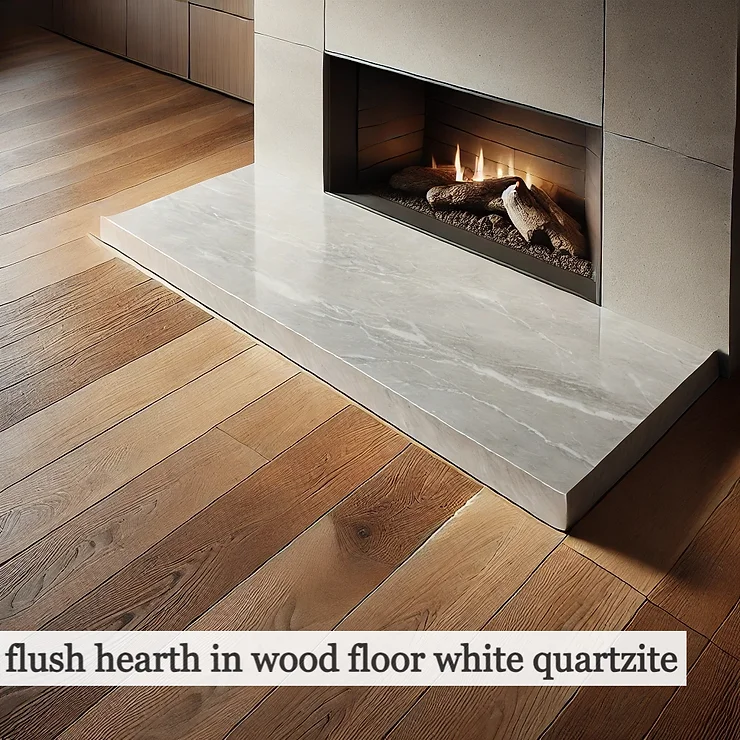A flush hearth in wood sits level with the floor, ensuring a seamless transition from the fireplace to the hardwood floor. White quartzite is durable and heat-resistant, making it an ideal material for hearths. To achieve a polished finish, use trim or molding around the hearth to ensure the transition between the hardwood floor and the fireplace is both stylish and safe. Light concrete hearths or stone hearths paired with wood flooring add texture and character.
Vinyl plank flooring around the fireplace is an affordable alternative that maintains a cohesive look. Safety considerations, such as proper fireplace height and suitable materials, are crucial, especially when incorporating elements like wood stoves.
What is a flush hearth?
Contents
A flush hearth sits level with the floor, creating a smooth transition from the fireplace to the surrounding hardwood floor. This design is perfect for those who want a sleek and modern look. It provides a seamless fireplace hearth that integrates effortlessly with the room. The hearth level with the floor makes the space feel open and cohesive.
Choosing the right materials
White quartzite is an excellent choice for a flush hearth. It is durable, heat-resistant, and offers a clean, bright appearance. When installed on a wood floor, it creates a beautiful contrast that enhances the overall design of your fireplace area. Quartzite hearth installation requires careful planning, especially if you want the hearth flush with the wood floor. Additionally, a light concrete hearth can be considered for a more industrial and modern look, especially when combined with split stone face elements.
Hardwood floor and fireplace transition
The hardwood floor fireplace transition is crucial when designing a flush hearth. The wood floor around the fireplace should blend seamlessly with the hearth. To achieve this, you might need to use trim or molding around the fireplace hearth. This ensures a clean and polished look. Using tongue and groove fireplace installation techniques can help in creating a smooth connection between the wood floor and the flush hearth.
Designing the fireplace border and trim
The fireplace border serves as the frame around the fireplace and can be crafted using a variety of materials. For a cohesive look, you can use wood trim around the fireplace to match the hardwood flooring. This will create a unified appearance. Molding around the brick fireplace is another option to consider if you have a brick surround. Fireplace trim molding floor is essential to cover the transition between the floor and the hearth.
Flooring options around the fireplace
The flooring around the fireplace hearth can vary depending on your preference. While hardwood is a popular choice, vinyl plank flooring around the fireplace is also an option for those who want a more affordable and easy-to-maintain solution. Whether you choose wood or vinyl, the key is to ensure that the fireplace floor hearth aligns flush with the surrounding floor for a seamless look.
Designing a modern fireplace hearth
Modern fireplace hearth ideas include using a white quartzite hearth with a flush hearth design. This creates a minimalist and contemporary look. For a more rustic touch, consider a stone hearth with a wood floor. If you want a unique texture, wood planks on the fireplace can add warmth and character to the space. A light concrete hearth flush floor paired with a wood floor also offers a sleek and industrial vibe.
Enhancing the heart area
To enhance the hearth area, you can add fireplace hearth trim to give a finished look to the transition between the hearth and the floor. If you have a brick fireplace, adding trim around the brick fireplace or floor trim around the brick fireplace can create a refined border. The fireplace floor molding not only adds style but also protects the edges of the hearth.
Safety and practicality
When designing a flush hearth, safety is essential. The fireplace height from the floor should be considered, especially if you plan to place a wood stove on the wood floor. Ensure that the hearth meets safety standards to protect your home. If you’re replacing a fireplace hearth, consult professionals to ensure proper installation and safety.
Adding finishing touches
Finally, consider adding decorative elements like a fireplace surround that complements the flush hardwood floor. You can also incorporate elements like fireplace floor trim to add depth and interest to the design. Fireplace flooring options like rugs or mats can also enhance the look and protect the flooring in front of the fireplace.
Conclusion:
Designing a stunning flush hearth in wood floor white quartzite involves careful planning and attention to detail. By choosing the right materials, ensuring a smooth transition between the wood floor and hearth, and adding stylish borders and trims, you can create a beautiful fireplace area that is a focal point in your home. Whether you prefer a modern look with a white quartzite hearth or a rustic charm with wood and stone elements, the possibilities are endless.

